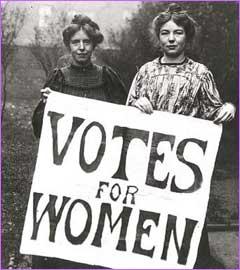As the new silhouette dramatically changed fashion, Paul Poiret became the most exciting couturier up to the first world war.
Poiret created the hobble skirt and between 1900 and 1914 many women adapted Poiret's design. The slim silhouette was then complimented by large hats.
Suffragettes
This was a movement for women's suffrage in the united kingdom and this was coined by the daily mail as a label for the members during the late 19th and early 20th century.
In 1912 the suffragettes turned to a more militant way of protesting and began chaining themselves to railings.
The suffragettes worn mainstream fashion garments but did opt for wearing purple, white and green as these signified dignity, purity and hope.

Menswear

Men were expected to have large wardrobes and dress appropriately whilst keeping up with fashion trends. However slowly the clothing became less formal and the lounge suit became popular.
London's Savile Row and Bond Street became the place to visit as British tailoring was considered the best in the world and wealthy people shopped at the famous established tailors along them.
This period of time saw the decline of the top hat, which from 1914 was only worn at formal occasions.
Smoking jackets were more widely worn and the soft fabrics, with embellished cuffs allowed the wearer to relax.
World War I
The suffragettes worn mainstream fashion garments but did opt for wearing purple, white and green as these signified dignity, purity and hope.

Menswear
Men were expected to have large wardrobes and dress appropriately whilst keeping up with fashion trends. However slowly the clothing became less formal and the lounge suit became popular.
London's Savile Row and Bond Street became the place to visit as British tailoring was considered the best in the world and wealthy people shopped at the famous established tailors along them.
This period of time saw the decline of the top hat, which from 1914 was only worn at formal occasions.
Smoking jackets were more widely worn and the soft fabrics, with embellished cuffs allowed the wearer to relax.
World War I
However the high society began to be effected by war, people could no longer afford luxury couture and because many couturiers were men they signed up for the service, this left women in charge.
Because America did not enter the war until 1917 they supported many of the french fashion houses. Although the war created setbacks Paris kept its title as the forefront of fashion despite challenge from american talent.
France's latest fashion styles still created great interest around the world, and in 1916 Conde Nast launched a British edition of Vogue to boost morale and create more interest in fashion during the war.
The silhouettes didnt change much through this period remained column like with layered skirts, peplums and drapes.
In 1915 some designers used military influences to design their collections this was mainly colours and shape, khaki wa very popular.
Tailored jackets and suits with waist belts were very fashionable.
The hobble skirt became sofetr and flared with pleats or tiered layers, by 1916 hemlines rose and practicality was important.
Clothing that needed detailed cleaning and pressing was soon modified due to a shortage of domestic labour.
Daywear became very important and people no longer embraced the playfulness of evening dresses.
Gabrielle Chanel
 Chanel was initially a milliner and opened her own store in 1913 in Deauville. She did the most to transform wartime dress and made her money selling to rich refugees escaping wartime Paris. This enabled her to open a couture house in Biaritz in 1915.
Chanel was initially a milliner and opened her own store in 1913 in Deauville. She did the most to transform wartime dress and made her money selling to rich refugees escaping wartime Paris. This enabled her to open a couture house in Biaritz in 1915.Chanel's sporty wartime clothes were simple two piece jersey outfits were the vitue of simplicity.
Previously Jersey had been used in sportswear and underwear for men, Chanel made this material the height of fashion.
Women loved her clothes and this meant that manufacturers were quick to copy her styles.
From 1916 increasing number of men joined the forces and more women entered the work forces and these jobs required practical clothing.
Women adopted men's styles creating a new approach to working clothing.
More practical bust bodices were worn, they were now used to support the body and not shape it. In 1916 the bra was developed out of the bust bodice.
Beyond the War

After the war France continued to lead the fashion industry and a huge demand for wedding dresses gave the fashion industry a boost, giving couture houses a roaring trade.
In 1921 Chanel became the first fashion designer to put her name to a perfume both designing the bottle and the scent and Chanel No 5 was launched.


No comments:
Post a Comment